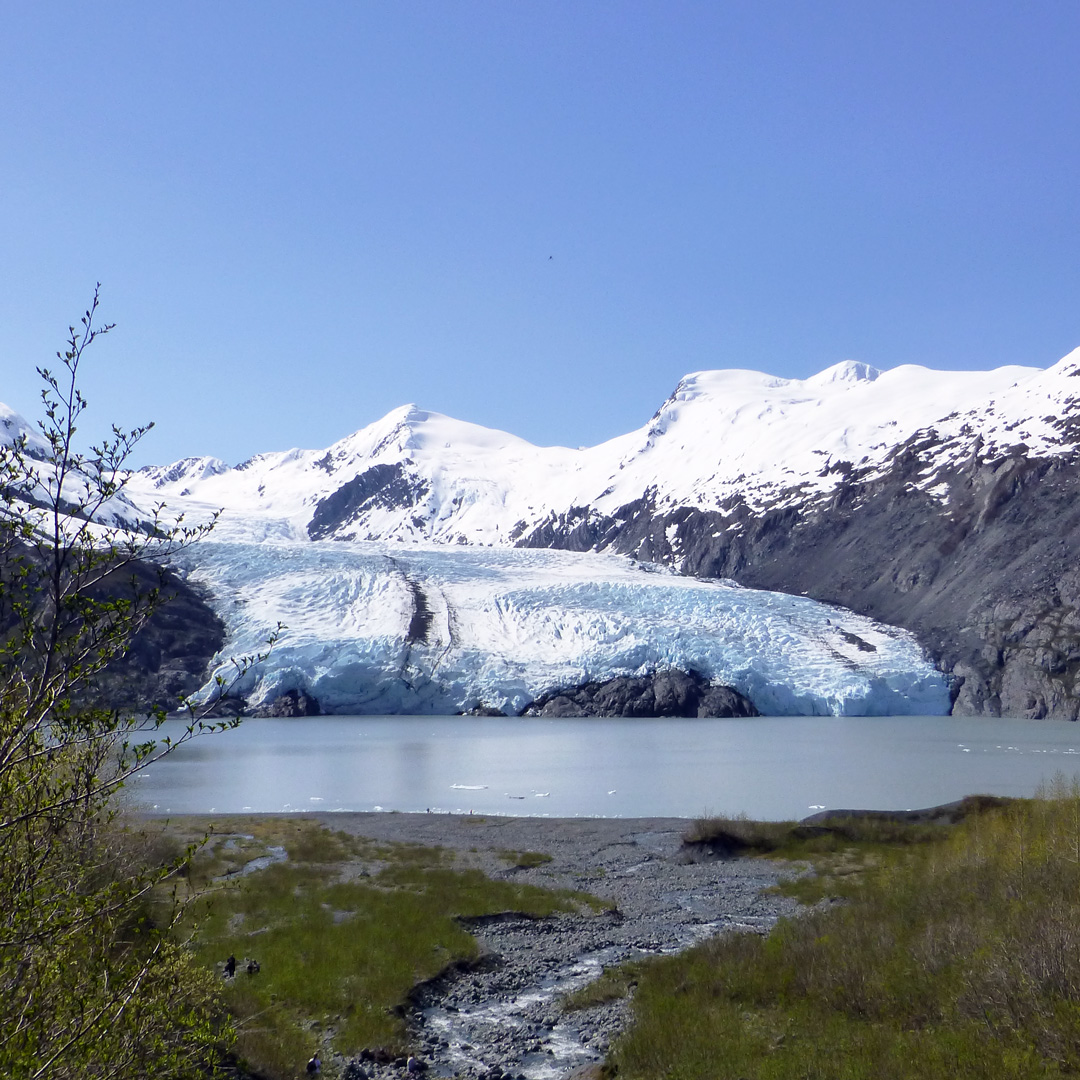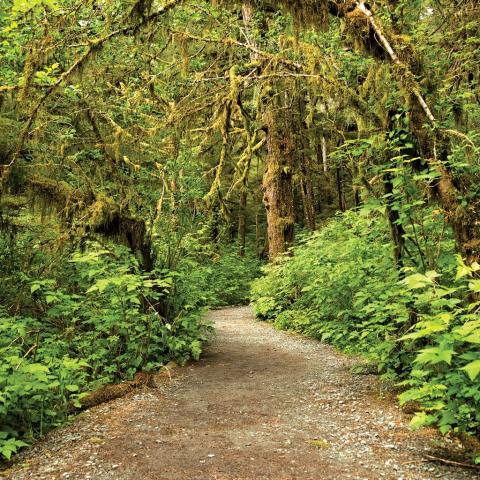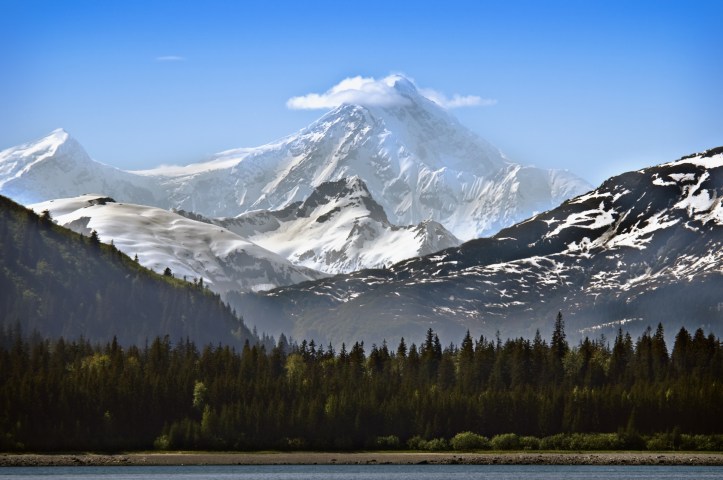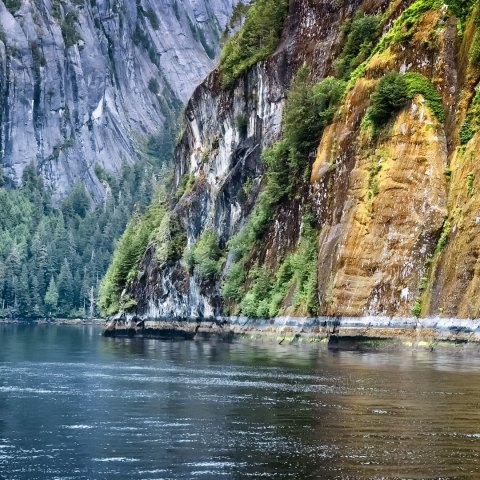Hiking, Climbing, and Seeing the Portage Glacier
Fifty miles south of Anchorage on the Seward Highway is the turnoff to Portage Glacier and Whittier. The old town of Portage was located here, along the Placer River where it flows into Turnagain Arm. The massive 1964 earthquake dropped the land 6-10 feet, flooding Portage with saltwater, but you can still see ruins of the old Portage Garage, along with a “ghost forest” of dead spruce trees. The salt acted as a preservative, and many trees are still standing more than 50 years later.
Today, Portage has an Alaska Railroad station on the east side of the highway and the Alaska Wildlife Conservation Center on the west side. Portage Highway heads east from here to Portage Glacier before passing through a long tunnel and ending at the town of Whittier.
Portage Highway is a six-mile access road through scenic Portage Valley to Portage Glacier. The glacier is one of the more popular tourist attractions in Southcentral Alaska, so be ready to share the ride with busloads of cruise ship travelers.

Visitors Center
The Forest Service’s Begich, Boggs Visitor Center (907/783-2326 or 907/783-3242, daily 9am-6pm late May-mid-Sept., $5 adults, free for kids under 16) is named after Nicholas Begich (U.S. representative from Alaska and father of former U.S. Senator Mark Begich) and Hale Boggs (majority leader of the U.S. Senate and father of journalist Cokie Roberts), whose plane disappeared in the area in 1972. They were never found. A large picture window overlooks the narrow outlet of Portage Lake. When the visitors center first opened in 1986, the glacier was readily visible, but it is now out of sight around a corner, and in recent years the number of icebergs entering the lake has decreased greatly as it continues to shrink as the climate warms.
The visitors center boasts an array of displays, including an ice cave, a small iceberg hauled in from the lake, an engrossing relief map of local icefields, and everything you ever wanted to know about glaciers, including displays on glacial motion and crevasses. Don’t miss the vial of tiny iceworms, which inhabit the surfaces of glaciers, feeding on pollen grains and red algae and surviving within a delicate, near-freezing temperature range. A 20-minute film, Retreat and Renewal, describes the changing world of Portage Glacier.
During the summer, Forest Service naturalists lead half-mile “iceworm safari” nature walks (assuming funding is available). The fish platform near Williwaw Campground is a good place to see spawning red and chum salmon in late summer.
Seeing the Portage Glacier
To see Portage Glacier, you’ll need to hop onboard the 200-passenger Ptarmigan tour boat (907/277-5581 or 888/452-1737, $39 adults, $19 kids); catch it at the dock near the visitors center. Operated by Gray Line of Alaska and staffed by Chugach National Forest naturalists, these one-hour cruises across Portage Lake start at 10:30am, with the last tour at 4:30pm. Gray Line offers the option to combine the boat tour with round-trip bus transportation from Anchorage ($86 adults, $46 kids).
Hiking the Portage Glacier
Two hikes are within walking distance of the visitors center. The Moraine Loop Trail, accessible from the path to the lodge, is a five-minute stroll through typical moraine vegetation; Portage Glacier occupied this ground only 100 years ago. Follow the access road past the visitors center (south) just under a mile. At the back of the parking lot starts the Byron Glacier Trail, an easy 0.75-mile walk along the runoff stream to below this hanging glacier.
At Williwaw Campground, the 1.25-mile Williwaw Nature Trail provides an easy introduction to the area, and Trail of the Blue Ice continues to the Begich, Boggs Visitor Center.
Camping the Portage Glacier
Two seasonal Forest Service campgrounds near Portage contain woodsy sites. Black Bear Campground ($15) has 13 sites for tent camping and is not recommended for RVs. The larger Williwaw Campground (518/885-3639 or 877/444-6777, $18-28) has 60 tent and RV sites (no hookups), plus a wheelchair-accessible observation platform where spawning salmon are visible in the summer. Williwaw’s sites can be reserved ($10 fee).
Alaska Wildlife Conservation Center
One of Alaska’s most popular visitor attractions, the 140-acre Alaska Wildlife Conservation Center (AWCC, 907/783-2025, daily 8am-8pm early May-mid-Sept., daily 10am-5pm mid-Sept.-Dec., Sat.-Sun. 10am-5pm Jan.-Feb., daily 10am-6pm Mar.-early May, $13 adults, $9 military and seniors, free for kids under 13) sits along Turnagain Arm just across the Seward Highway from the turnoff to Portage Glacier. This nonprofit game farm for orphaned and injured Alaskan animals houses brown and black bears, wood bison, moose, elk, musk oxen, Sitka black-tailed deer, lynx, caribou, coyotes, bald eagles, and even Snickers the famous (on YouTube at least) porcupine. AWCC is a hit with all ages, providing an up-close look at animals you normally see from a distance—if at all. The 18-acre bear facility (largest in the United States) is particularly impressive, with an elevated walkway to separate people from the brown and black bears.
Visit in early summer for the chance to watch those ever-cute musk ox babies. For a more informative visit, join one of the free daily programs that include caribou walks, lynx feeding, small animal programs, and brown bear feeding. Free shuttle bus tours are offered eight times a day. A fun children’s playground is across from the AWCC gift shop.
Use extreme caution when turning into AWCC off the busy Seward Highway; multiple fatalities have occurred at this intersection. The Alaska Railroad’s Portage train station is directly across the road, and they offer a special Rail and Wildlife Day Trip ($175 pp) that includes a visit to AWCC and a train ride to the scenic Grandview region.

By clicking ‘Sign Up,’ I acknowledge that I have read and agree to Hachette Book Group’s Privacy Policy and Terms of Use


